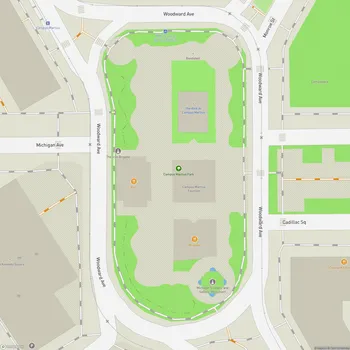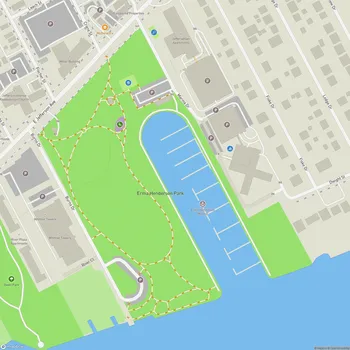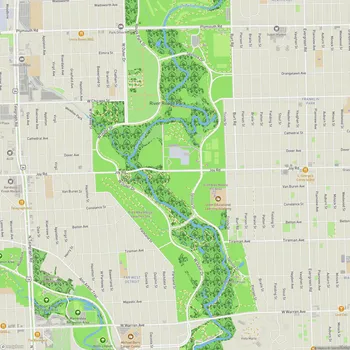William G. Milliken State Park
Interactive Park Map
About William G. Milliken State Park
Michigan's First Urban State Park
Nestled along the Detroit River just east of downtown, the William G. Milliken State Park spans 31 acres of green refuge amid the urban landscape. As Michigan's first urban state park, it's a breath of fresh air offering both recreational fun and educational experiences for city dwellers and visitors alike.
The park began life as Tri-Centennial State Park and Harbor before being renamed in 2009 to honor Governor William G. Milliken. It offers a green space for those wanting a break from the urban environment while still staying within city limits.
Harbor and Lighthouse
One of the park's standout features is its harbor, opened in 2004, complete with a 52-slip marina for boaters to dock and explore. The 63-foot lighthouse at the harbor entrance is modeled after the Tawas Point Light and helps guide maritime traffic along the Detroit River.
If you're arriving by boat, you'll appreciate the clean facilities, including showers and restrooms. The marina welcomes both regular slip owners and travelers just passing through, making it an ideal pit stop while exploring Detroit's waterways.
Wetlands Restoration
The park's second phase, completed in 2009, brought a fascinating wetlands restoration area that does double duty - it creates wildlife habitat while showing visitors how nature filters water before it returns to the Detroit River.
The interpretive signs scattered throughout this section explain the ecological processes taking place in the wetlands. These restored wetlands recreate what the riverbank might have looked like before urban development, and they've become home to various birds and small critters that add life to the park.
Recreational Pathways
The Detroit Riverwalk meanders through the park, well-suited for a leisurely stroll, bike ride, or rollerblading session with the river as your backdrop. The path doesn't end at the park boundaries either - it connects to other Detroit hotspots via the Riverwalk and the Dequindre Cut Greenway.
The seven-mile stretch of Riverwalk offers views of Detroit's skyline on one side and Canada on the other. If you forgot your binoculars, don't worry - public ones are available at various points for a closer look at the Canadian shore or passing boats.
Amenities and Features
When you're ready to take a break, head to one of the covered picnic pavilions or try your luck at the fishing platforms along the shoreline. Take note of the memorial dedicated to Peter Stroh, whose advocacy helped ensure public access to this beautiful waterfront.
For the best views in the park, climb up to the upper berm area where panoramic vistas of the river await. This area is thoughtfully designed with accessibility in mind, featuring walkways with handrails and lush greenery. It's a prime spot for wildlife watching, picnicking, or catching a sunrise over the Detroit skyline.
You'll discover clean restrooms across the park (with water bottle filling stations - a nice touch!), plenty of benches for when your feet need a rest, and grassy areas fantastic for spreading out a blanket. During summer, the carousel adds a touch of whimsy, and the Riverfront Cafe offers refreshments when hunger strikes.
Family-Friendly Features
If you're visiting with kids, you'll appreciate the play areas scattered throughout where little ones can burn off energy safely. The water features that pop up during warmer months are particularly popular with children looking to cool off while having fun.
Dog owners, your four-legged friends are welcome too! The park is dog-friendly, with waste bags available so you can clean up after your pup. The Riverwalk makes for an excellent dog-walking route with scenic views to enjoy along the way.
Ecological Importance
Beyond just being pretty, the restored wetlands serve a crucial ecological purpose. These habitats mirror what existed before settlement and provide essential stopover points for migratory birds. The park's commitment to environmental stewardship is evident in how these natural areas are maintained and protected.
Keep your eyes peeled while exploring - you might spot various bird species, and some visitors have even reported seeing grouse and other wildlife hiding in the meadow grasses on the hill area.
Nearby Attractions
The park's location makes it a great launching pad for Detroit adventures. You can rent bikes or scooters to explore the full length of the Riverwalk, or check out the Outdoor Adventure Center nearby for more educational experiences.
Milliken State Park combines natural spaces with urban accessibility and historical elements, allowing visitors to experience both nature and the city's maritime heritage in one location.
All Features & Facilities
Nature & Wildlife
Water Features & Activities
Visitor Services
Food & Gathering
Photo Gallery
ParkMagnet Score
Great Park
Park Size
Opening Hours
Weather
Top Restaurants Near William G. Milliken State Park
Andiamo Detroit Riverfront
0.4 miles400 Renaissance Center A-03, Detroit, MI 48243
Upscale Northern Italian bistro featuring elegant dining with scenic Detroit River views and diverse wine selections.
Highlands Detroit
0.4 miles400 Renaissance Center floor 71, Detroit, MI 48243
Upscale restaurant on the 71st floor offering fine dining with spectacular city views.
Breadless
0.4 miles2760 Larned St, Detroit, MI 48207
Health-focused sandwich shop serving fresh lettuce-wrapped sandwiches, bowls, and salads with creative flavor combinations.
Top Hotels Near William G. Milliken State Park
Detroit Marriott at the Renaissance Center
0.4 milesRenaissance Center, 400 Renaissance Dr W, Detroit, MI 48243
High-rise hotel offering comfortable accommodations with stunning city and river views from upper floors.
Hollywood Casino at Greektown
0.6 miles1200 St Antoine, Detroit, MI 48226
Polished casino hotel featuring modern rooms with floor-to-ceiling windows and premium amenities downtown.




